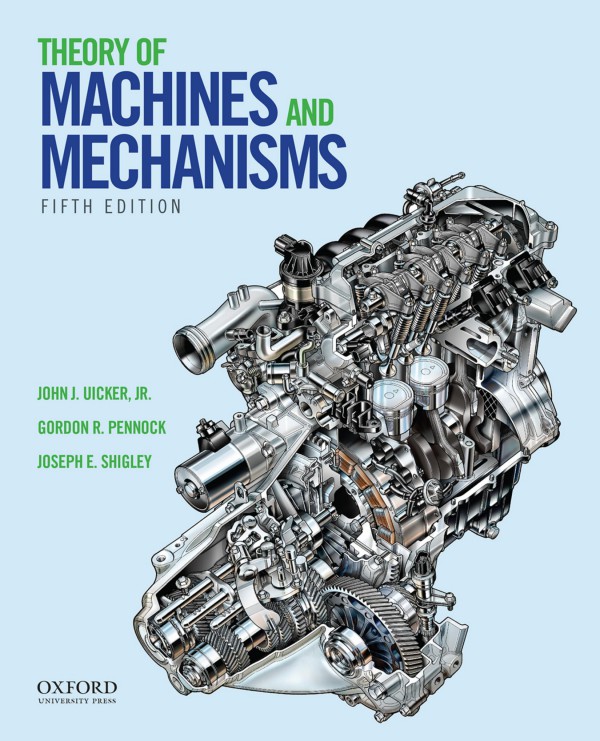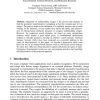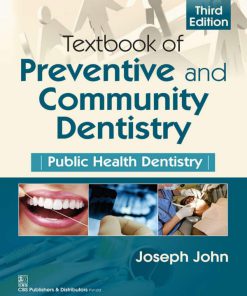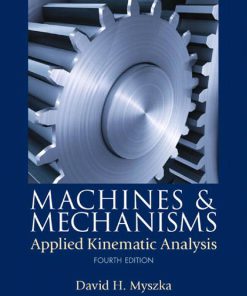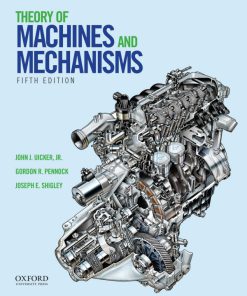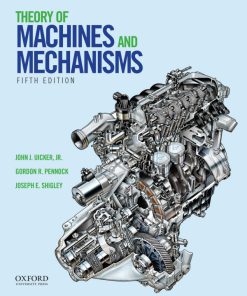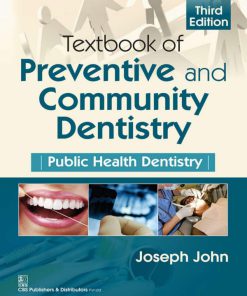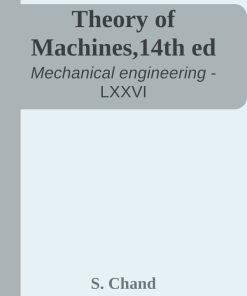Theory of Machines and Mechanisms 5th Edition by John Uicker, Gordon Pennock, Joseph Shigley ISBN 0190658908 9780190658908
$50.00 Original price was: $50.00.$25.00Current price is: $25.00.
Authors:John J. Uicker , Series:Mechatronics Engineering [73] , Tags:Engineering (General) , Author sort:Uicker, John J. , Ids:9780199454167 , Languages:Languages:eng , Published:Published:Nov 2017 , Publisher:Oxford University Press , Comments:Comments:All rights reserved. No part of this publication may be reproduced, stored in a retrieval system, or transmitted, in any form or by any means, without the prior permission in writing of Oxford University Press, or as expressly permitted by law, by license, or under terms agreed with the appropriate reproduction rights organization. Inquiries concerning reproduction outside the scope of the above should be sent to the Rights Department, Oxford University Press, at the address above.
Theory of Machines and Mechanisms 5th Edition by John J. Uicker Jr., Gordon R. Pennock, Joseph E. Shigley – Ebook PDF Instant Download/Delivery. 0190658908, 978-0190658908
Full download Theory of Machines and Mechanisms 5th Edition after payment
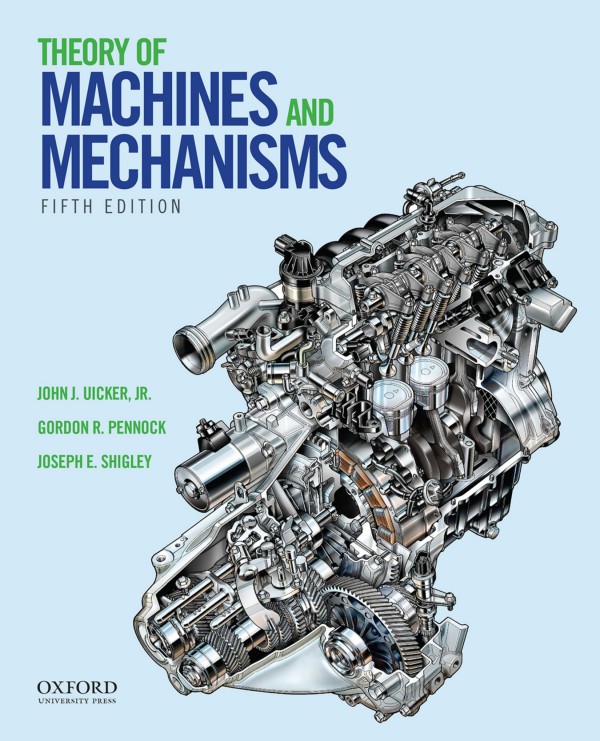
Product details:
ISBN 10: 0190658908
ISBN 13: 978-0190658908
Author: John J. Uicker Jr., Gordon R. Pennock, Joseph E. Shigley
Theory of Machines and Mechanisms, Fifth Edition, is an ideal text for the complete study of displacements, velocities, accelerations, and static and dynamic forces required for the proper design of mechanical linkages, cams, and geared systems. The authors present the background, notation, and nomenclature essential for students to understand the various independent technical approaches that exist in the field of mechanisms, kinematics, and dynamics. The fifth edition features streamlined coverage and substantially revised worked examples. This latest edition also includes a greater number of problems, suitable for in-class discussion or homework, at the end of each chapter.
FEATURES
* Offers balanced coverage of all topics by both graphic and analytic methods
* Covers all major analytic approaches
* Provides high-accuracy graphical solutions to exercises, by use of CAD software
* Includes the method of kinematic coefficients and also integrates the coverage of linkages, cams, and geared systems
* An Ancillary Resource Center (ARC) offers an Instructor’s Solutions Manual, solutions to 100 of the problems from the text using MatLab, and PowerPoint lecture slides
* A Companion Website includes more than 100 animations of key figures from the text
Theory of Machines and Mechanisms 5th Table of contents:
PART 1. KINEMATICS AND MECHANISMS
1. The World of Mechanisms
- 1.1 Introduction
- 1.2 Analysis and Synthesis
- 1.3 Science of Mechanics
- 1.4 Terminology, Definitions, and Assumptions
- 1.5 Planar, Spheric, and Spatial Mechanisms
- 1.6 Mobility
- 1.7 Characteristics of Mechanisms
- 1.8 Kinematic Inversion
- 1.9 Grashof’s Law
- 1.10 Mechanical Advantage
- 1.11 References
- 1.12 Problems
2. Position, Posture, and Displacement
- 2.1 Locus of a Moving Point
- 2.2 Position of a Point
- 2.3 Position Difference Between Two Points
- 2.4 Apparent Position of a Point
- 2.5 Absolute Position of a Point
- 2.6 Posture of a Rigid Body
- 2.7 Loop-Closure Equations
- 2.8 Graphic Posture Analysis
- 2.9 Algebraic Posture Analysis
- 2.10 Complex-Algebra Solutions of Planar Vector Equations
- 2.11 Complex Polar Algebra
- 2.12 Posture Analysis Techniques
- 2.13 Coupler-Curve Generation
- 2.14 Displacement of a Moving Point
- 2.15 Displacement Difference Between Two Points
- 2.16 Translation and Rotation
- 2.17 Apparent Displacement
- 2.18 Absolute Displacement
- 2.19 Apparent Angular Displacement
- 2.20 References
- 2.21 Problems
3. Velocity
- 3.1 Definition of Velocity
- 3.2 Rotation of a Rigid Body
- 3.3 Velocity Difference Between Points of a Rigid Body
- 3.4 Velocity Polygons; Velocity Images
- 3.5 Apparent Velocity of a Point in a Moving Coordinate System
- 3.6 Apparent-Angular Velocity
- 3.7 Direct Contact and Rolling Contact
- 3.8 Systematic Strategy for Velocity Analysis
- 3.9 Algebraic Velocity Analysis
- 3.10 Complex-Algebraic Velocity Analysis
- 3.11 Method of Kinematic Coefficients
- 3.12 Instantaneous Centers of Velocity
- 3.13 Aronhold-Kennedy Theorem of Three Centers
- 3.14 Locating Instantaneous Centers of Velocity
- 3.15 Velocity Analysis Using Instant Centers
- 3.16 Angular-Velocity-Ratio Theorem
- 3.17 Relationships Between First-Order Kinematic Coefficients and Instant Centers
- 3.18 Freudenstein’s Theorem
- 3.19 Indices of Merit; Mechanical Advantage
- 3.20 Centrodes
- 3.21 References
- 3.22 Problems
4. Acceleration
- 4.1 Definition of Acceleration
- 4.2 Angular Acceleration
- 4.3 Acceleration Difference Between Points of a Rigid Body
- 4.4 Acceleration Images
- 4.5 Apparent Acceleration of a Point in a Moving Coordinate System
- 4.6 Apparent-Angular Acceleration
- 4.7 Direct Contact and Rolling Contact
- 4.8 Systematic Strategy for Acceleration Analysis
- 4.9 Algebraic Acceleration Analysis
- 4.10 Complex-Algebraic Acceleration Analysis
- 4.11 Method of Kinematic Coefficients
- 4.12 Euler-Savary Equation
- 4.13 Bobillier Constructions
- 4.14 Instantaneous Center of Acceleration
- 4.15 Bresse Circle (or de La Hire Circle)
- 4.16 Radius of Curvature of a Point Trajectory Using Kinematic Coefficients
- 4.17 Cubic of Stationary Curvature
- 4.18 References
- 4.19 Problems
5. Multi-Degree-of-Freedom Planar Linkages
- 5.1 Introduction
- 5.2 Posture Analysis; Algebraic Solution
- 5.3 Velocity Analysis; Velocity Polygons
- 5.4 Instantaneous Centers of Velocity
- 5.5 First-Order Kinematic Coefficients
- 5.6 Method of Superposition
- 5.7 Acceleration Analysis; Acceleration Polygons
- 5.8 Second-Order Kinematic Coefficients
- 5.9 Path Curvature of a Coupler Point Trajectory
- 5.10 Finite Difference Method
- 5.11 References
- 5.12 Problems
PART 2. DESIGN OF MECHANISMS
6. Cam Design
- 6.1 Introduction
- 6.2 Classification of Cams and Followers
- 6.3 Displacement Diagrams
- 6.4 Graphic Layout of Cam Profiles
- 6.5 Kinematic Coefficients of Follower
- 6.6 High-Speed Cams
- 6.7 Standard Cam Motions
- 6.8 Matching Derivatives of Displacement Diagrams
- 6.9 Plate Cam with Reciprocating Flat-Face Follower
- 6.10 Plate Cam with Reciprocating Roller Follower
- 6.11 Rigid and Elastic Cam Systems
- 6.12 Dynamics of an Eccentric Cam
- 6.13 Effect of Sliding Friction
- 6.14 Dynamics of Disk Cam with Reciprocating Roller Follower
- 6.15 Dynamics of Elastic Cam Systems
- 6.16 Unbalance, Spring Surge, and Windup
- 6.17 References
- 6.18 Problems
7. Spur Gears
- 7.1 Terminology and Definitions
- 7.2 Fundamental Law of Toothed Gearing
- 7.3 Involute Properties
- 7.4 Interchangeable Gears; AGMA Standards
- 7.5 Fundamentals of Gear-Tooth Action
- 7.6 Manufacture of Gear Teeth
- 7.7 Interference and Undercutting
- 7.8 Contact Ratio
- 7.9 Varying Center Distance
- 7.10 Involutometry
- 7.11 Nonstandard Gear Teeth
- 7.12 Parallel-Axis Gear Trains
- 7.13 Determining Tooth Numbers
- 7.14 Epicyclic Gear Trains
- 7.15 Analysis of Epicyclic Gear Trains by Formula
- 7.16 Tabular Analysis of Epicyclic Gear Trains
- 7.17 References
- 7.18 Problems
8. Helical Gears, Bevel Gears, Worms, and Worm Gears
- 8.1 Parallel-Axis Helical Gears
- 8.2 Helical Gear Tooth Relations
- 8.3 Helical Gear Tooth Proportions
- 8.4 Contact of Helical Gear Teeth
- 8.5 Replacing Spur Gears with Helical Gears
- 8.6 Herringbone Gears
- 8.7 Crossed-Axis Helical Gears
- 8.8 Straight-Tooth Bevel Gears
- 8.9 Tooth Proportions for Bevel Gears
- 8.10 Bevel Gear Epicyclic Trains
- 8.11 Crown and Face Gears
- 8.12 Spiral Bevel Gears
- 8.13 Hypoid Gears
- 8.14 Worms and Worm Gears
- 8.15 Summers and Differentials
- 8.16 All-Wheel Drive Train
- 8.17 Note
- 8.18 Problems
9. Synthesis of Linkages
- 9.1 Type, Number, and Dimensional Synthesis
- 9.2 Function Generation, Path Generation, and Body Guidance
- 9.3 Two Finitely Separated Postures of a Rigid Body (N = 2)
- 9.4 Three Finitely Separated Postures of a Rigid Body (N = 3)
- 9.5 Four Finitely Separated Postures of a Rigid Body (N = 4)
- 9.6 Five Finitely Separated Postures of a Rigid Body (N = 5)
- 9.7 Precision Postures; Structural Error; Chebychev Spacing
- 9.8 Overlay Method
- 9.9 Coupler-Curve Synthesis
- 9.10 Cognate Linkages; Roberts-Chebychev Theorem
- 9.11 Freudenstein’s Equation
- 9.12 Analytic Synthesis Using Complex Algebra
- 9.13 Synthesis of Dwell Mechanisms
- 9.14 Intermittent Rotary Motion
- 9.15 References
- 9.16 Problems
PART 3. DYNAMICS OF MACHINES
11. Static Force Analysis
- 11.1 Introduction
- 11.2 Newton’s Laws
- 11.3 Systems of Units
- 11.4 Applied and Constraint Forces
- 11.5 Free-Body Diagrams
- 11.6 Conditions for Equilibrium
- 11.7 Two- and Three-Force Members
- 11.8 Four- and More-Force Members
- 11.9 Friction-Force Models
- 11.10 Force Analysis with Friction
- 11.11 Spur- and Helical-Gear Force Analysis
- 11.12 Straight-Tooth-Bevel-Gear Force Analysis
- 11.13 Method of Virtual Work
- 11.14 Introduction to Buckling
- 11.15 Euler Column Formula
- 11.16 Critical Unit Load
- 11.17 Critical Unit Load and Slenderness Ratio
- 11.18 Johnson’s Parabolic Equation
- 11.19 References
- 11.20 Problems
12. Dynamic Force Analysis
- 12.1 Introduction
- 12.2 Centroid and Center of Mass
- 12.3 Mass Moments and Products of Inertia
- 12.4 Inertia Forces and d’Alembert’s Principle
- 12.5 Principle of Superposition
- 12.6 Planar Rotation about a Fixed Center
- 12.7 Shaking Forces and Moments
- 12.8 Complex Algebra Approach
- 12.9 Equation of Motion From Power Equation
- 12.10 Measuring Mass Moments of Inertia
- 12.11 Transformation of Inertia Axes
- 12.12 Euler’s Equations of Motion
- 12.13 Impulse and Momentum
- 12.14 Angular Impulse and Angular Momentum
- 12.15 References
- 12.16 Problems
13. Vibration Analysis
- 13.1 Differential Equations of Motion
- 13.2 A Vertical Model
- 13.3 Solution of the Differential Equation
- 13.4 Step Input Forcing
- 13.5 Phase-Plane Representation
- 13.6 Phase-Plane Analysis
- 13.7 Transient Disturbances
- 13.8 Free Vibration with Viscous Damping
- 13.9 Damping Obtained by Experiment
- 13.10 Phase-Plane Representation of Damped Vibration
- 13.11 Response to Periodic Forcing
- 13.12 Harmonic Forcing
- 13.13 Forcing Caused by Unbalance
- 13.14 Relative Motion
- 13.15 Isolation
- 13.16 Rayleigh’s Method
- 13.17 First and Second Critical Speeds of a Shaft
- 13.18 Torsional Systems
- 13.19 References
- 13.20 Problems
14. Dynamics of Reciprocating Engines
- 14.1 Engine Types
- 14.2 Indicator Diagrams
- 14.3 Dynamic Analysis-General
- 14.4 Gas Forces
- 14.5 Equivalent Masses
- 14.6 Inertia Forces
- 14.7 Bearing Loads in a Single-Cylinder Engine
- 14.8 Shaking Forces of Engines
- 14.9 Computation Hints
- 14.10 Problems
15. Balancing
- 15.1 Static Unbalance
- 15.2 Equations of Motion
- 15.3 Static Balancing Machines
- 15.4 Dynamic Unbalance
- 15.5 Analysis of Unbalance
- 15.6 Dynamic Balancing
- 15.7 Dynamic Balancing Machines
- 15.8 Field Balancing with a Programmable Calculator
- 15.9 Balancing a Single-Cylinder Engine
- 15.10 Balancing Multi-Cylinder Engines
- 15.11 Analytic Technique for Balancing Multi-Cylinder Engines
- 15.12 Balancing of Linkages
- 15.13 Balancing of Machines
- 15.14 References
- 15.15 Problems
People also search for Theory of Machines and Mechanisms 5th:
shigley theory of machines and mechanisms
borrow theory of machines and mechanisms
theory of machines and mechanisms by ghosh and mallik pdf
theory of mechanisms and machines ghosh and mallik solutions
theory of machines and mechanisms by joseph edward shigley

